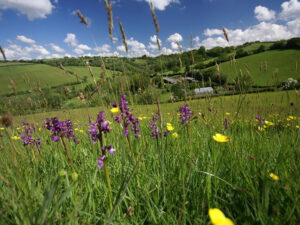What wildlife-rich looks like:
Mature trees with dead and decaying wood, hollows and cracks. Fungi, lichens, insects, roosting bats and nesting birds.
Many wood pastures are what remains of medieval hunting forests.
Ancient trees found in wood pasture and parkland provide valuable habitat for rare and specialist species.
Mature trees with dead and decaying wood, hollows and cracks. Fungi, lichens, insects, roosting bats and nesting birds.
Lichens: Dead wood lichens
True flies: Dead wood flies
Bats
UK priority habitat: Yes
Statutory irreplaceable habitat: Veteran trees and some sites which are on the ancient woodland inventory.
Wood pasture and parkland is an open, grassy habitat, usually grazed and defined by scattered ancient and veteran trees. Wood pastures are often old medieval hunting forests that evolved from woodlands into more open landscapes through deer grazing. Many are no longer sufficiently grazed and have reverted to woodland. Examples of wood pasture in Devon include Ashclyst Forest and Glenthorne Woods.
In the 18th and 19th centuries, parkland landscapes, including deer parks, were designed and created around prominent country houses. Examples include National Trust properties such as Killerton, Saltram, Arlington and Knightshayes. Some of our urban public parklands such as Devonport in Plymouth and Phear Park in Exmouth are remnants of these country estates.
The old trees in these landscapes were often pollarded, an ancient form of management where the crown was felled above the browsing height of grazing stock. Pollarding produces timber and fodder.
Ancient and veteran trees have developed features such as decaying and dead wood, holes, flaking bark, cavities and hollow trunks. These features provide habitat for rare and specialist wildlife, particularly rare lichens and mosses, fungi, birds and bats. The list of Devon Species of Conservation Concern and the Ancient and veteran trees page have more information. See Actions below for relevant Focus Species.
Wood pastures and parklands that have been in existence since 1600 are mapped on the Ancient Woodland Inventory.
The 2007 Devon inventory of wood pasture and parkland estimated that there are 4,063 hectares in Devon. This includes 162 parkland sites and 47 wood pastures.
Sites of Special Scientific Interest (SSSIs) 4: Arlington, Dunsland Park, Ugbrooke Park, Whiddon Deer Park.
County Wildlife Sites (CWS) 43 Parkland CWS and 28 Wood Pasture CWS, covering over 1,800 hectares. Around 42 parklands are thought to be of CWS quality but have not been designated. Many sites are protected as they are Registered Parks and Gardens.
CWS 7 have been monitored since 2011. By area, 57% were assessed to be Green and 43% Amber (Green and Amber are explained on the CWS page).
See Key pressures and opportunities below to find out why not all sites are assessed as Green.
The biggest pressure identified in the 2007 Devon parkland and wood pasture inventory was root damage to trees. A key cause of this damage is compacted soil due to livestock (especially where feeders are placed too close to trees), vehicles and people. Compacted soil affects roots and their mycorrhiza fungi. Other causes of root damage are drought, standing water, physical damage through re-seeding and disruption to mycorrhiza fungi from applying fertilisers.
Veteran trees are old and near the end of their life. There are often too few replacement trees, particularly in parklands. Dead and decaying wood in the trees and that has fallen to the ground is critical wildlife habitat and an essential source of nutrients for the trees. However, it is often removed.
Many parkland grasslands have been reseeded and are not species rich. Overgrazing and compacted soil is also a problem (see above).
Research by Cranfield University has shown that grazed wood pasture is 5% more effective at absorbing and storing carbon than the same area of separate woodland and grassland. Slow-growing, long-lived trees such as oak that grow in the open, store more carbon than faster-growing and short-lived species. (reference needed)
Wood pastures and parklands are important historical landscapes and a valuable visual, recreational and educational resource. Many are open to the public, providing income for their owners.
Some farmers in Devon are starting to plant trees in grasslands (known as silvo-pasture) to create wood pastures of the future. Dung from livestock enriches the soil, while the trees provide shelter and fodder and increase soil health.
Ash dieback is a significant threat across Devon. Other current diseases include acute oak decline and sweet chestnut blight.
Funding for management of wood pasture and parkland is available through ELM (see Find out more below).
See Find out more below for links to detailed guidance and sources of funding and advice.
Better (wildlife-rich), bigger and more wood pastures and parklands that are connected to a network of habitats across the landscape.
See Find out more below for relevant national and local targets.
Develop and implement a management plan based on Countryside Stewardship specifications, see Find out more. Management plans should be informed by habitat and species surveys and past and current management.
Develop plans based on Countryside Stewardship specifications, see Find out more.
More detailed actions are set out for the following Focus Species:
XX TO ADD
Follow the links below to the relevant Focus Species pages as well as to relevant habitat and wider theme pages:
Wildlife will benefit from these actions being carried out across Devon. However, actions are prioritised to the following High Opportunity Areas (in bold). See Mapping for the LNRS Viewer and information on how areas have been mapped.
Wood pasture and parkland (existing)
Woody expansion/buffer zones around wood pasture and parkland sites.
There’s lots of great work going on across Devon for wood pasture and parkland. For example:
The Devon Ancient Tree Forum (ATF Devon) brings together specialists, enthusiasts and ancient tree owners to share best practice and visit sites across Devon.

Insert more text here –

You can find more projects at xxxxx. If you are helping wood pasture and parkland please add your project.
Always follow the Countryside Code and stick to footpaths and sites that are managed for public access.
Parklands with public access include National Trust properties at Killerton, Saltram, Arlington and Knightshayes (entry charges may apply), Dartington Estate near Totnes and urban parks such as Devonport in Plymouth and Phear Park in Exmouth.
For information on visiting these and other sites see the Explore Devon website.

The add link later has more information on wood pasture and veteran tree sites in Devon.
Find out about the Devon Ancient Tree Forum (ATF Devon).
The Trees outside woodlands page has more information on veteran and ancient trees.
Natural England Summary of Evidence: Wood-Pasture and Parkland (PDF)
JNCC Priority Habitat Description: Wood-Pasture and Parkland (PDF)
The People’s Trust for Endangered Species has information on the UK Wood Pasture & Parkland Network
The Soil Association has information about agroforestry.
The UK Forestry Standard is the government’s approach to sustainable forest management. It has information on how to manage ancient trees.
The government’s website, GOV.UK, has information on the: